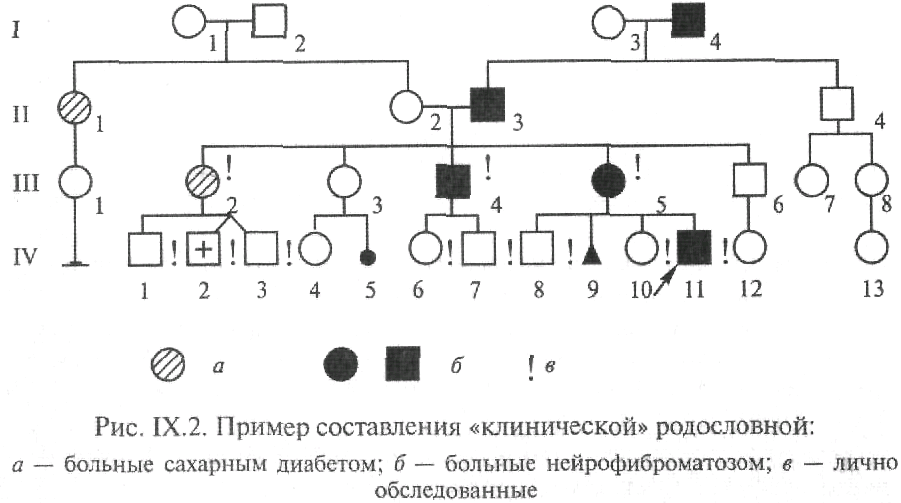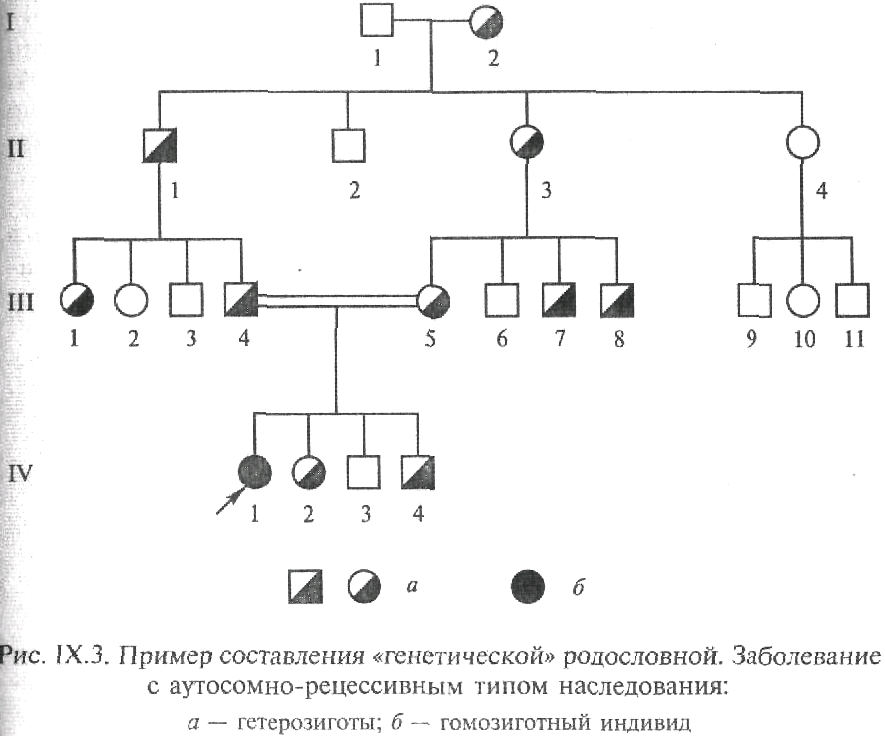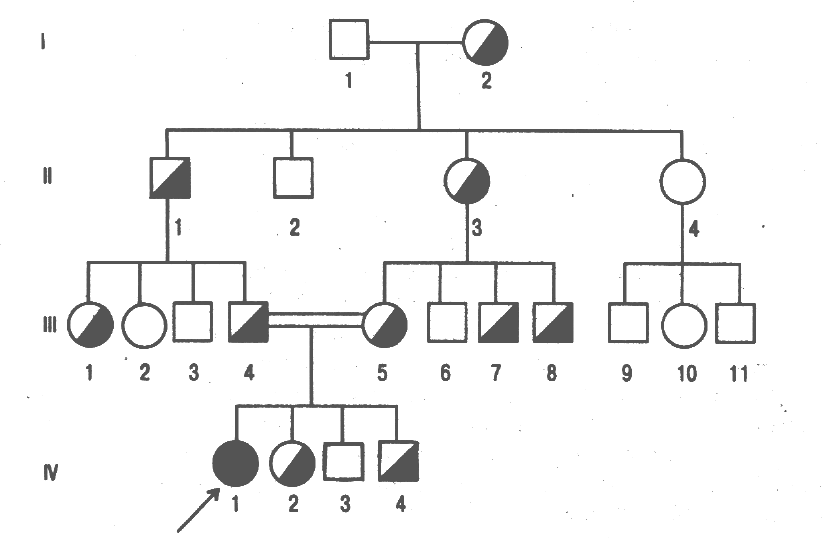6. Drawing up a pedigree
Compilation of a pedigree begins with collecting information about the family, and above all with collecting information about proband- an individual who is the subject of interest of a researcher (doctor, teacher). Most often it is a patient or a carrier of the studied trait. However, healthy individuals can also seek medical genetic counseling. In this case, the term "consulting" is used. In the graphic representation of the pedigree, the proband is marked with a corresponding sign and an arrow that goes from bottom to top and from left to right. Children of one parental couple (brothers and sisters) are called siblings. If siblings have only one common parent, they are called half siblings. Distinguish between single uterine (common mother) and half-blood (common father) siblings. A family in a narrow sense is a parental couple and their children (nuclear family), but sometimes a wider circle of blood relatives. In the latter case, it is better to use the term "genus".
Usually a pedigree is collected in connection with the study of one or more diseases (signs). A doctor or geneticist is always interested in a particular disease or symptom.
Depending on the purpose of the study, the pedigree can be complete or limited: it can reflect either clinical signs or the genetic status of the members of the pedigree. In any case, you need to strive for the most complete compilation of the pedigree in the ascending, descending and lateral directions. The more a generation is involved in a pedigree, the more information it can contain. However, its vastness can lead to the appearance of erroneous data in it. To clarify the information, various kinds of medical documentation, photographs of relatives, and the results of additional research are used. The greater the depth and breadth of the genealogical search, the more valuable and reliable the information received.
For clarity, the collected data is depicted in the form of certain symbols, some of which are shown in Fig. IX.1.
Rice. 1X.1. The most common symbols used in pedigrees are:
1 - a male person;2 - a female person;3 - sick;4 - marriage; 5 - consanguineous marriage;6 - siblings;7 - uterine siblings;8 - consanguineous siblings;9 - monozygotic twins;10 - dizygotic twins;11 - adoption;12 - gender unknown;13 - miscarriage;14 - medical abortion;15 - dead;16 - proband;17 - heterozygous individuals;18 - heterozygous carrier of a recessive gene on the X chromosome;19 - pregnancy;20 - barren marriage;21 - personally examined
By "clinical" pedigree is meant the display of the inheritance of a particular disease or several diseases. The maximum number of diseases (signs) in one symbol, i.e. in one individual, in the graphic image should not exceed four nosological forms or signs. If the clinical pedigree is devoted to the analysis of only one specific disease, then the designations correspond to the image of a male patient and a female patient. If two diseases are traced in the clinical pedigree, for example, hypertension and obesity, then the following designations are usually used: each symbol is divided into two equal parts, while patients with the first disease (hypertension) are designated as obese patients as In this pedigree, the symbol would denote a male individual, suffering from hypertension and obesity at the same time.
In some cases, different types of shading of elements are used to represent different diseases in the pedigree (Fig. IX.2). The graphic representation of the pedigree is supplemented by the mandatory sections: "Symbols" and "Pedigree legend".

Conditional designations are a list of symbols used to graphically represent a pedigree. As a rule, standard symbols are used (Fig. IX.1). However, depending on the tasks, goals and characteristics of pedigrees, the compiler has the right to use the original (own) designations with their obligatory explanation in order to exclude the possibility of misinterpretation of the data. To clarify the principles of designating and compiling pedigrees, two examples are given (Fig. 1X.2 and 1X.Z).

Legend pedigree is a required element of the pedigree description. It includes:
1) a detailed description of each member of the pedigree, information about which is mandatory or essential for understanding the nature of the inheritance of the disease (sign) or the characteristics of the clinical manifestation;
2) a list of sources of medical and other information with meaningful information;
3) an indication of the nature of the pathological process or its localization (for example, some members of the pedigree are diagnosed with an isolated malignant tumor of the stomach, others have multiple neoplasias);
4) an indication of the time of the onset of the disease and the features of the course;
5) indication of age and cause of death;
6) a description of diagnostic and identification methods (for example, the qualitative or quantitative nature of the described (feature).
Thus, the "Legend of the pedigree" is information about the members of the pedigree with a detailed description of any information that is necessarily essential for the analysis.
Generations are indicated by Roman numerals from top to bottom, usually placed to the left of the pedigree. The last generation of ancestors for which information was collected is designated as generation I. All elements of one generation (the entire row) are numbered from left to right, sequentially in Arabic numerals. Siblings are listed in the pedigree in order of birth. Thus, each member of the pedigree has its own coordinates, for example, in the pedigree shown in Fig. IX.2, maternal grandfather of the proband - II-3, has neurofibromatosis.
All individuals of one generation should be located strictly in one row. "Hanging" symbols between generations is a gross mistake. If the pedigree is extensive, then the generations can be arranged not in horizontal rows, but in concentric circles (Fig. IX.4). In the pedigree, it is important to mark those personally examined for the presence of a sign of illness or disease.
The researcher should strive to obtain objective primary material, which is the basis of statistical and genetic analysis.
GENETIC ANALYSIS OF PEDIGREE
The main purpose of studying genealogical data is to establish genetic patterns associated with the analyzed disease or trait.
To detect the hereditary nature of a trait (disease) and establish the type of inheritance, various methods of statistical processing of the data obtained are used.
The laws of inheritance discovered by Mendel obey only those hereditary diseases, the cause of which (etiological factor) is a mutation of one gene. Depending on the chromosomal localization and characteristics of the gene, they are distinguished:
autosomal dominant and autosomal recessive types of inheritance, when the gene is located in one of 22 pairs of autosomes (nonsex chromosomes);
X-linked dominant and recessive types of inheritance, when the gene is located on the X chromosome;
Y-siegothenic (Hollandric) inheritance, when the gene is located on the Y-chromosome;
mitochondrial (cytoplasmic) inheritance, when a mutation occurs in the mitochondrial genome.
It is important to understand that in some cases, calculations of the ratio of the number of sick and healthy in one particular family may give an incorrect idea of the type of inheritance. This is mainly due to the random nature of the distribution of chromosomes during gametogenesis. In a particular family, the ratio of sick to healthy children may differ significantly from the theoretically expected ratio typical for a particular type of inheritance. However, the nature of the pedigree, the characteristics of the transmission of the disease (trait) in generations, compliance with the criteria for inheritance of one type or another, allow us to draw a certain conclusion about the type of inheritance of the pathology (trait) in a particular family.
Rice. 1. Pedigree of a family with Minkowski Shoffard anemia (autosomal dominant inheritance)

Rice. 2. Pedigree with an autosomal recessive mode of inheritance of the disease (adrenogenital syndrome)
Rice. 3. Pedigree of a family with Duchenne muscular dystrophy (X-linked recessive inheritance)
Rice. 4. Pedigree of patients with bronchial asthma.
GENETIC PROBLEMS.
Problem number 1
A girl whose father suffers from hemophilia marries a healthy man.
What kind of children can you expect from this marriage?
Create a pedigree.
Problem number 2
A boy of three days, from a 27-year-old mother with diabetes. He was born at the time of the first pregnancy, with a body weight of 4700 g, a body length of 53 cm. The appearance of the child attracted attention: a swollen, moon-shaped face, a short thick neck. From the first hours of life, he developed respiratory distress syndrome. The borders of the heart are expanded to the left to the mid-axillary line. In the study, hypoglycemia was found in the blood.
Additional research needed.
Presumptive diagnosis.
Problem number 3
Child, 10 months. Was born from the first pregnancy. Delivery on time with birth weight of 3300 g, body length - 52 cm. Pregnancy was uneventful. Shouted at once. Attached to the breast in the first 30 minutes of life, sucked willingly. I was gaining weight well. Artificially fed from one month with the "Tonus" mixture. Pale skin, blue eyes. By now, the head does not hold, does not sit, teeth are 2/2. Large fontanelle 1X1 cm. Does not hold toys, does not recognize parents. Body weight 8.5 kg, body length - 70 cm, head circumference - 45 cm. On examination, an unpleasant odor from the child is determined. A cousin of this child was sick in the pedigree.
Your Proposed Diagnosis.
The type of inheritance of this disease.
Problem number 4
Analyze the data on twins in the table in order to determine the role of heredity and environmental factors in the development of traits:
Note: MB - monozygous twins; DB are dizygotic twins.
Problem number 5
A child from 2 pregnancies, 2 urgent deliveries with a body weight of 3500 g, body length - 52 cm, head circumference - 36 cm. The first pregnancy ended in stillbirth. The mother is 23 years old, the father is 25 years old. Parents consider themselves healthy. From the first day of life, the child does not tolerate feeding well, spits up. Dyspeptic symptoms, bloating were noted. On the third day, an icteric coloration of the skin and sclera appeared, which after 5-6 days had no tendency to decrease. On the part of the lungs and heart, no pathology was revealed. Liver + 4cm, spleen + 2cm. At the age of one month, there was a lag in neuropsychic development (does not smile, does not keep the head in the position on the stomach). The body weight gain in the first month was 350g. On examination by an ophthalmologist, a cataract was diagnosed. Laboratory examination: complete blood count (10 days) Er. - 5.2X10 12 / l; HB - 140 g / l; Ht 0.42; Lake. - 10.2X10 9 / l; n-2, s-24, l-72, m-2; ESR - 3 mm / h, blood sugar - 2.1 mmol / l; general urine analysis - relative density - 1002; protein - traces; leukocytes - 0-1 in the field of view.
Presumptive diagnosis.
Inheritance type.
Forecast for future siblings.







